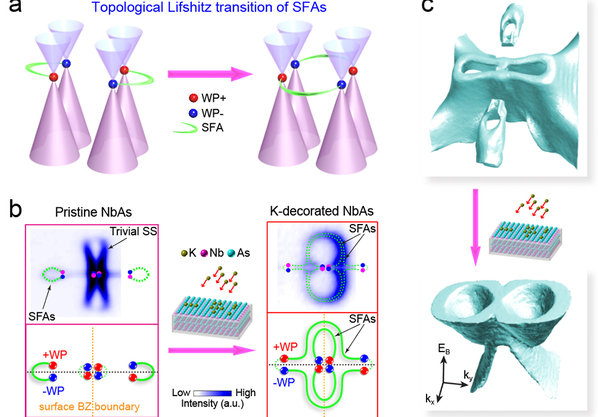Recently, an SPST team of researchers led by Professor Chen Yulin successfully demonstrated in-situ manipulation of surface Fermi arcs (SFAs) – the signature electronic structures of Weyl semimetal – and realized their topological Lifshitz transition via surface decoration in ultra-high vacuum environment. The study, “Topological Lifshitz transitions and Fermi arc manipulation in Weyl semimetal NbAs,” was published online Friday, Aug 2 in Nature Communications.
SFAs are unique open Fermi surfaces discovered recently in topological Weyl semimetals (TWSs). Unlike closed Fermi surfaces in conventional materials, these unusual topological electronic features can give rise to many exotic phenomena, such as anomalous SFA-mediated quantum oscillations, chiral magnetic effects, unusual three-dimensional quantum Hall effect, non-local voltage generation, and anomalous electromagnetic wave transmission. Therefore, the capability of controlling and modifying the SFAs, especially the switching of SFAs between Weyl points’ pairs, are naturally desired in order to understand and manipulate these exciting and unusual phenomena.
In their work, using in-situ surface (potassium) decoration, an international collaboration of researchers from ShanghaiTech University, Oxford University, Tsinghua University, Max Planck Institute for Chemical Physics of Solids, Princeton University, and Weizmann Institute of Science demonstrated a successful manipulation of the shape, size and even the connections of SFAs in a model TWS (NbAs), and observed their evolution leading to an unusual topological Lifshitz transition using angle-resolved photoemission spectroscopy (ARPES). The phase transition “teleports” the SFAs between different parts of the surface Brillouin zone, and despite the dramatic surface evolution, the existence of SFAs is robust and each SFA remains tied to a pair of Weyl points of opposite chirality, as dictated by the bulk topology. This method of controlling and manipulating the topological electronic states of TWSs in this work will not only open a new frontier for the exploration of fundamental physical phenomena, but also make possible the design of unusual electronic applications mediated by SFAs.
Read more at: https://www.nature.com/articles/s41467-019-11491-4

Surface potassium decoration induced topological Lifshitz transition of SFAs of topological Weyl semimetal NbAs. a. Schematic illustration. b. Surface band structure and sketch of SFA connectivity pattern of the pristine and potassium-decorated NbAs. c. 3D illustration of band structures of the pristine and potassium-decorated NbAs (credit: Fu Zhenxiao of SPST).

